Stadt & Land
Transforming War into Art: Anti-Tank Obstacle Hedgehog – Kyiv Defender
Pending
Pending
Mihel Mazepovich, Sofia Bondar, Denny Uhorchuk
At the start of the invasion, our Kyiv cultural community made tank barriers to defend our city. Now we transform them into urban art like benches and bicycle racks. We want to share them with you and have creative instructions on how to upcycle them. Our “hedgehogs” are a reminder of the war and the power of culture to bring about positive change.
With the beginning of Russia’s invasion, our cultural community of Kyiv musicians, artists, architects, decorators, designers and other cultural workers became civil resistance.
People who once created culture began to design tank barriers (“hedgehogs”) and bulletproof vests to make a small contribution to the resistance of our beloved city. We made about 300 hedgehogs and 2000 bulletproof vests, showing the world our resistance:
NBC: https://www.youtube.com/watch?v=yKWRfkYR57A
France24: https://observers.france24.com/en/europe/20220304-ukraine-artists-in-kyiv-work-12-hours-a-day-making-anti-tank-obstacles
TV2: https://nyheder.tv2.dk/udland/2022-03-08-tv-2-moeder-ukrainsk-modstandsgruppe-vi-er-som-partisaner
After Kyiv was successfully defended and the invaders withdrew from the region, we went back to what we do best: Creating culture.
One of the projects we launched is the "Anti-Tank Obstacle Hedgehog - Kyiv Defender”, which transforms the symbols of war into useful and meaningful urban objects. https://hedgehogs.kosmostabir.org/
Our project's mission is to upcycle anti-tank hedgehogs into useful architectural objects that serve three purposes:
art in urban use
memory and warning
and obstacles for tanks.
The upcycled objects are designed to quickly transform into anti-tank hedgehogs if needed and can be installed in different Ukrainian and European cities as a symbol of resistance.
To ease the process of sharing our upcycled hedgehogs with the world, architect Sofia Bondar, who has been actively involved in our civil resistance movement, has created a comprehensive manual describing the steps to recycle the hedgehogs into useful architectural objects.
Manual: https://drive.google.com/file/d/1w2huqBeMYQaDOSARB9AkBpdg1e8GR_pR/view
The symbolism of our project lies in the complex and painful process of war, which can have both negative and positive consequences. Even though war can lead to change and development, it is important to remember its terrible impact on people's lives and to strive for peace and conflict resolution.
The initiative is part of the story of a new culture and art, the rebuilding of cities, the importance of upcycling and remembering the terrible consequences of war.
The objects consist of anti-tank hedgehogs and a functional part, which defines the type of urban object, such as a bench, lantern, bicycle rack, or table. They bear the project's logo, a red rat on a yellow hedgehog, symbolising the evil of war and the good of resistance. All massive parts are made of metal, with no plastic.
Placing the upcycled objects in European cities is an act of care, remembrance and solidarity with the Ukrainian people, while benefiting local citizens. At the same time, we want to share our experience and resources with others when it comes to defence and resilience. As an example of the expansion of the project beyond Ukraine, one of the upcycled benches was placed in the Pilecki Institute in Berlin, Germany.
Our culture-urban project transforms the symbols of war into meaningful and useful urban objects and serves as a reminder of the consequences of war, the importance of peace, and the power of culture and art to create positive change.
Additional information
| Type | Installation |
|---|---|
| Language | English |
More sessions
| 6/5/23 |
A presentation on how #ROSHOP Modular House, a media and digital culture informed housing prototype for complex post-conflict and politically unstable environments, was created at the Pagirinya South Sudanese Refugee Settlement in Uganda, as a response to urgent community-use housing needs.
|
| 6/5/23 |
Presentation of PhD research (Northumbria University / Mozilla Foundation) focused not on waste management but rather on waste prevention through collective practices of material reuse in cities and regions.
|
| 6/5/23 |
Wie sieht sie aus, die klimafreundliche und gerechte Mobilität im Jahr 2040? Und welche Rolle spielen digitale Lösungen dabei? In diesem Podcast-Format geben Jana Zieger (stadtnavi) und Sarah-Indra Jungblut (RESET.org) zukunftsfähigen Visionen und innovativen Lösungen eine Bühne.
|
| 6/5/23 |
Agriculture in sub-Saharan Africa has been delayed by the youth for several reasons including the lack of mechanization, the hardship of the work... Food crops have given way to export crops such as coffee, cocoa, rubber, etc In addition to the transmission of know-how, it's a question of discovering a new attractive, alternative ecological method
|
| 6/5/23 |
Current discussions about future cities are limited to our visual senses. We see many pictures of the future that contain smart infrastructure and new vehicles. But we have more senses. So, how does the future city sound if we put new vehicles on the roads and in the air? Listen in as we experience the city of the future from an angle that you have
|
| 6/6/23 |
Let’s re-imagine our food system. In this workshop, participants will explore how citizens, together with maker spaces, Fab Labs and Fab Cities, can support distributed, social food hubs. Using a future(s) design tool and supporting e-book, we’ll reflect on innovative paths to reclaiming the food system.
|
| 6/6/23 |
There are vast networks of fungi under our feet that have existed for thousands of years; some stretch for thousands of kilometres, connecting trees, plants and other life together in an entangled mesh of mutual support and care. What if our digital social platforms were more like fungi networks?
|

